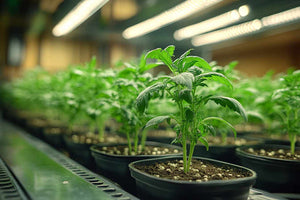Modern LED Grow lights for plants are able to create the most favorable conditions for their growth. Moreover, we distinguish them by economical energy consumption, ease of use, reliability and safety. During operation, the grow light does not heat up.
This means it does not cause the slightest harm to plants. Grow lights have a universal shape and design, due to which they are easily fixed on any surface.

OCTOPUS 400 grow lights for plants
Lighting for plants can be divided into several types:
- Illumination of plants in the autumn and winter seasons, when natural light is not enough;
- Creation of all the necessary conditions for germination of seedlings before their subsequent placement in the ground;
- Illumination of aquariums for algae cultivation;
Growing flowers in greenhouses and agricultural industry
In order for your houseplant to grow and develop rapidly, you need to make sure that it receives sufficient light. As you know, a plant cannot exist without photosynthesis. And we need sunlight to carry out this process.
If the plant receives enough light in summer, then at other times of the year it is best to arrange additional lighting. For these purposes we use LED Grow lights for plants. Therefore, the best grow light is OCTOPUS 400.
All indoor plants are divided into three categories depending on the need for lighting:
- Flowers that need intense sunlight;
- Flowers that can grow under the influence of ambient light;
LED Grow lights for plants is Able to thrive in low light conditions
In the vastness of the modern market, you can find and buy grow lights with waves of various lengths. The use of grow lights has many advantages. With the help of these devices, the flower will be able to better assimilate chlorophyll A, which is one of the main sources of energy for most plants.
Due to the use of this component, the growth of flowers is accelerated, and their root system develops much more productively, while the metabolism is significantly improved.
Why should you use OCTOPUS400 Grow light?
Due to the regular use of LED Grow lights for plants, phytohormones more actively release. Hence, it increases the natural protective qualities of plants.
Today, you can buy a wide variety of types of lighting for plants, but the best, safest and most reliable option is still an LED grow light. All models of grow lights available for sale are distinguished by their compact dimensions and attractive design.
How to choose grow lights for plants?
It is much easier and more convenient to purchase a ready-made grow light than to assemble it yourself from individual components. The purchased grow light should not generate ultraviolet and infrared rays, as they have a negative effect on the flower.
LED Grow lights for plants heats up intensively during its operation can burn or dry out a young plant, therefore, you should be careful about the temperature indicators. A high quality grow light from a trusted brand will provide the flower with a sufficient amount of light and nutritional components at any time of the year without causing the slightest harm to it.
Indoor growing with LED step by step
Indoor LED cultivation is the latest trend in the creation of indoor orchards and gardens. It does not matter if you live in the center of the city or if you do not have a balcony or terrace suitable for growing plants.
If you decide to create a space for growing indoors, you will not only improve the aesthetics of your environment. In addition, you will be improving air quality and providing yourself with organic and delicious food.
Below we will detail the main aspects to take into account so that our home garden works perfectly.
Grow space
Growing plants inside a home can take up as much space or as little as we want. From a window, a table, a shelf or a whole room: the limits of the garden are set by us.
Depending on the place of cultivation we will have to adapt the area so that the task is as comfortable and clean as possible. After all, we are using significant amounts of land and water indoors.
Indoor LED grow lights
Light is essential in the development of photosynthesis, a chemical process essential for plant life. Normally, in the absence of light, the plants grow tall, thin and without leaves or, at most, some not fully extended.
Obviously, if the plant does not receive all the light it needs, it will neither flower nor bear fruit. For our plants to grow and develop correctly we have to provide them with enough light and this happens by choosing a suitable LED Grow lights for plants. For this we have to consider various aspects.
Light intensity
The early stages of plant growth, when in the state called seedling, require a lot of light and even the sunniest window may not be enough.
Seedlings need a lot of light
Having specific lighting with LED indoor grow lights allows us to control exactly the intensity of the light that our plants receive. The most widespread recommendation is to place our LED grow lamp between 5 and 7 centimeters above the seedling. 
As more leaves grow and develop, we will move the lamp so that it is always between 8 cm and 10 cm above the foliage. Since the LED lights emit little heat there is no danger of burning the plants.
How many hours of light do plants need?
It all depends on the variety but most vegetables and greens can need up to 18 hours of light a day. The hours of darkness are equally important for healthy growth.
The best way to keep the light on for the required hours is to use a timer that automatically turns the lights on and off throughout the day.
Light color
The best light is obviously natural light. As for artificial light, LED indoor growing lighting, like the one we offer you in our online store, combines different wavelengths (red light and blue light). It comes in the proportion that is most beneficial for plant growth.
The color of the LED indoor grow light enhances growth.
Other aspects to consider
Apart from the LED Grow lights for plants, we have to pay attention to other factors such as the temperature. This must be between 18ºC and 24ºC, although it can oscillate more or less 6ºC.
Humidity is also a factor that we must pay attention to, especially when we use heating or air conditioning. If we see that the leaves in our indoor garden turn brown or begin to fall, we can regularly spray the plants or install a humidifier.

